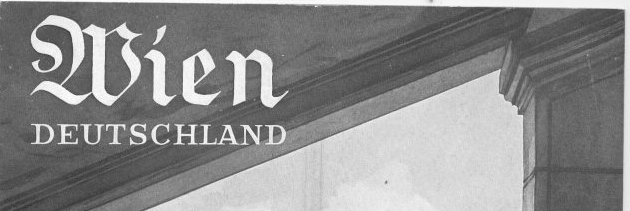 Amateur history nerd that I am, I’m quite pleased to have married into a family which has retained all sorts of books, newspapers and magazines dating from about 1920 onwards. The “In the Hausarchiv” series gives an occasional look at the things I’ve come across in our own “house archive”.
Amateur history nerd that I am, I’m quite pleased to have married into a family which has retained all sorts of books, newspapers and magazines dating from about 1920 onwards. The “In the Hausarchiv” series gives an occasional look at the things I’ve come across in our own “house archive”.
This week’s “In the Hausarchiv” presents a booklet full of attractive photos of the beautiful city in which I live, Vienna. Sounds nice, right? But this book is about Vienna, Germany! Is this the same Vienna I live in? Of course it is…
At midnight on March 11, 1938, the last Austrian government of the first republic — that of Chancellor Kurt von Schuschnigg — resigned office and on March 12, 1938, German troops entered Austria without resistance. In German this event is referred to as the Anschluss, or union. Austria ceased to exist, and instead became the Eastern March (Ostmark) of the Greater German Empire (Großdeutsches Reich.) During this period, until the fall of the National Socialist regime, the word “Austria” (Österreich) was out of favor (perhaps even illegal?), and to insist on using it was certainly to invite arrest.
(The most famous visible sign of the Austrian Resistance to National Socialism, the “O5″ which appears to this day on one of the outside walls of St. Stephen’s Cathedral, signifies Österreich, or more accurately the alternative spelling of Oesterreich: the letter “O” followed by the number 5, signifying the fifth letter of the alphabet, “e”: Oesterreich).
This “Wien, Deutschland” book featured here is from 1939, a year following the Anschluss. The cover shows a drawing of part of the Schönbrunn Palace, looking out from the main part of the palace towards the gardens and the Glorietta (the structure on the hill.)
The photo shown below, which also appears in this book, is of Vienna’s Rathaus. I’ve painstakingly blurred out every occurrence I could find of the swastika — and there were many — to be sure the image doesn’t show up on some other website which proudly features swastikas. The caption to the photo reads, “The Rathaus on 1. May of the year of the Liberation of the Ostmark.”




